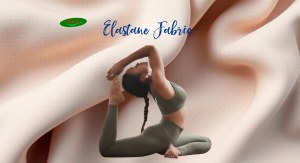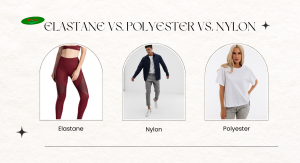The textile industry is continually evolving, and one of the most significant innovations has been the creation of covered spandex yarn. This type of yarn is essential for various applications, providing a unique combination of stretch, recovery, and durability. In this article, we will deeply explore various types of elastic yarn, shedding light on their properties, uses, and the science that makes them indispensable in contemporary fabric production.
Covered spandex yarn

Covered spandex yarn is primarily made of Spandex fiber, which is known for its exceptional elasticity. It is often wrapped or covered with a layer of another fiber, such as nylon or polyester, which enhances its durability and creates a softer touch. This combination allows manufacturers to produce fabrics that maintain their shape while still providing the comfort of stretch.
The elastic properties of covered spandex yarn have transformed how designers approach garment creation. Traditional fabrics often lacked elasticity, limiting the designs that could be realized. With the advent of covered spandex, designers can create fitted garments that hug the body while allowing freedom of movement. This has been particularly important in the sportswear and activewear markets, where comfort and flexibility are paramount.
The process of creating covered spandex yarn involves sophisticated manufacturing techniques. The inner spandex core provides stretch, while the outer layer protects it from degradation caused by exposure to sunlight, sweat, and other environmental factors. This two-layer approach not only extends the lifespan of the yarn but also enhances its performance in various functional textiles.
Properties of covered spandex yarn
Covered spandex yarn possesses numerous properties that make it a sought-after material in the textile industry.
First and foremost, the elasticity of the yarn is fundamental. It can stretch significantly and return to its original shape, which is crucial for garments that need to fit snugly and retain their shape over time. This inherent stretch aids in creating comfortable wear, particularly for active or fitted clothing.
Another important property is its durability. The outer layer of the yarn acts as a shield to the delicate spandex core, allowing the fabric to withstand wear and tear much more effectively than a non-covered version. This means that garments made from covered spandex yarn can endure frequent use without losing their functionality or appearance.
Moreover, the aesthetic versatility of covered spandex yarn cannot be overlooked. Since it can be produced in various colors and finishes, it allows designers infinite creativity in their fabric choices. This versatility makes it suitable for diverse applications, from fashion apparel to functional activewear, and even specialty garments like swimwear or dancewear.
Applications in fashion and sports
Covered spandex yarn has become a cornerstone for many design collections, particularly in fashion and sports. Its application in sportswear has revolutionized the industry, with athletes demanding materials that work with their bodies rather than against them. The seamless look and feel of fabrics made with covered spandex yarn provide not only functionality but also aesthetic appeal.
In fashion, covered spandex yarn has enabled a new genre of fitted designs that were previously challenging to achieve with traditional fabrics. The ability to create clothes that contour and shape to the body has led to a rise in form-fitting styles. As more designers explore these possibilities, the fashion landscape continues to evolve.
The adaptability of covered spandex yarn also allows for layers. Lightweight fabrics can be combined with heavier materials while maintaining desired stretch and recovery properties. This makes covered spandex an ideal choice for transitional pieces that need to provide warmth while allowing movement.
Production process and technological advancements
The production of covered spandex yarn has seen significant advancements in technology over the years. The process can involve multiple stages, including spinning, wrapping, and finishing, all of which have implications for the yarn’s final properties.
Innovations in spinning technology have improved the efficiency and quality of yarn production. High-speed spinning machines can produce finer, more consistent threads, leading to improved fabric performance and longevity. Furthermore, advancements in wrapping techniques allow for various fibers to be used in covering the spandex core, unlocking new design possibilities.
Finishing processes, such as thermal setting or chemical treatments, can also enhance the yarn’s properties. These processes might improve resistance to fading or wear, increase moisture-wicking capabilities, or provide additional softness. As technology advances, we can expect to see even more diverse applications and benefits from covered spandex yarn.
Covered elastic yarn

Covered elastic yarn is similar to covered spandex yarn but varies in the materials used for the outer covering and slightly in its intended applications. Instead of focusing mainly on spandex, covered elastic yarn can incorporate other elastic fibers, like rubber or lycra, encased in the outer layer. This feature changes its nature and functionalities slightly while still serving a very similar purpose.
The primary purpose of covered elastic yarn is to provide stretch and recovery in a multitude of textiles. It is widely used in various sectors, including lingerie, waistbands, and various knitted and woven fabrics. The use of covered elastic yarn ensures that these textiles have the necessary resilience and longevity while also enhancing comfort.
One of the most significant advantages of covered elastic yarn is its enhanced anti-slip properties. Traditional elastic often has a tendency to slip or shift, leading to garments that can become uncomfortable or lose their structural integrity. The covered structure ensures that the elasticity is maintained without unnecessary slippage, leading to better-fitted garments overall.
Versatility of covered elastic yarn
The versatility of covered elastic yarn contributes significantly to its widespread adoption across different markets. It is popular among clothing manufacturers, interior designers, and even upholstery fabric producers. With its ability to stretch and recover, it can deliver the aesthetic characteristics desired while maintaining functionality.
Particularly in lingerie, covered elastic yarn offers a snug fit without compromising comfort. It allows for the creation of garments that fit closely to the body without digging into the skin. This is particularly crucial for items that are worn under other clothing, where comfort and invisibility are key.
In activewear and sports apparel, the use of covered elastic yarn helps to promote freedom of movement while providing support in strategic areas. Many athletes are becoming increasingly mindful of the materials they wear, and the demand for functional yet fashionable activewear continues to grow. The unique properties of covered elastic yarn make it an ideal choice for fulfilling these requirements.
Fabrication techniques and trends
The methods by which covered elastic yarn is produced have also evolved over recent years. Increased automation has streamlined production processes, resulting in greater efficiency and consistency in the yarn produced. This has led to the introduction of various types of covered elastic yarn tailored to specific applications, enhancing market diversity.
Additionally, the trend toward sustainable practices within the textile industry is influencing the production of covered elastic yarn. Manufacturers are increasingly seeking environmentally friendly materials and processes to meet consumer demands. This push for sustainability creates new opportunities for innovation, from the development of recycled materials to eco-friendly production techniques.
Technological advancements continue to lead the way in how covered elastic yarn can be engineered. New fibers are being introduced that offer even greater elasticity, durability, and comfort, showing the potential for continued evolution in elastic yarn types.
Market demand and consumer preferences
Consumer preferences are shifting towards high-performance textiles, fueled by the popularity of active lifestyles and the burgeoning athleisure market. Covered elastic yarn meets this demand excellently, marrying aesthetic appeal with performance capabilities. Additionally, as individuals become more health-conscious, there is a rise in the demand for garments that support activity without restricting movement.
Market research indicates an increasing exposure of consumers to elastic fabrics, thanks in part to the proliferation of social media and influencers showcasing the latest trends. This increased visibility has educated consumers about the benefits of covered elastic yarn and encouraged them to seek out products that incorporate it.
The residual effects of these trends are not merely confined to the apparel market. As covered elastic yarn gains traction, sectors such as home textiles and automotive fabrics are likely to follow suit, leveraging the unique properties offered by this type of yarn.
Air covered spandex yarn
Air covered spandex yarn presents an innovative evolution of the traditional covered spandex yarn. By utilizing air in the covering process, this type of yarn is lighter and more breathable than its counterparts, making it an attractive option for many applications, particularly those requiring enhanced comfort or mobility.
The key difference between air covered spandex yarn and standard covered spandex yarn lies in the production method. In air covering techniques, spandex fibers are wrapped with filaments while introducing air into the covering process. This creates gaps between fibers, allowing for breathability while still retaining essential stretch and recovery characteristics.
As a result, air covered spandex yarn offers exceptional moisture management capabilities, which can be particularly beneficial in activewear. The breathable nature of the yarn allows for better airflow, reducing heat buildup during physical activity, thus improving overall comfort.
Advantages of air covered spandex yarn
One of the most significant advantages of air covered spandex yarn is its lightweight nature. Garments made from this type of yarn allow for a more enjoyable wearing experience, especially during warmer months. This feature contributes to the growing popularity of air covered spandex in the activewear and athleisure markets.
Furthermore, the improved moisture-wicking properties enhance the functionality of the fabric. It actively pulls moisture away from the skin, promoting quick drying and keeping the wearer comfortable even during intense workouts. This functionality makes it suitable for various athletic applications, from yoga to running.
The production of air covered spandex yarn can also be seen as a response to consumer preferences for lighter, more functional fabrics. As consumers increasingly seek clothes that enhance their active lifestyles, manufacturers are keen to deliver innovative solutions that meet these demands. The air covering technique has opened up new avenues for design, allowing for lighter, more breathable fabrics that do not compromise on elasticity.
Design considerations and applications
Designers working with air covered spandex yarn can explore new possibilities in their creations. The lightweight nature of this yarn allows for flowing, dynamic silhouettes that remain comfortable and maintain a level of modesty. This potential for innovative designs caters to a growing market for diverse activewear, including options that transition seamlessly from exercise to everyday wear.
Additionally, air covered spandex yarn can be combined with other fabrics and materials, leading to hybrid designs that offer even more desirable attributes. By blending performance-focused yarns with softer, natural materials, designers can provide garments that satisfy various consumer needs.
In activewear and athleisure, the use of air covered spandex offers more than just functional benefits; it also introduces opportunities for creative expression. Designers can experiment with the drape, texture, and visual appearance of garments, contributing to the uniqueness and aesthetic appeal of their lines.
Future trends in air covered spandex yarn
As the textile industry progresses, air covered spandex yarn is poised for further innovation. Emerging technologies and synthetic fibers may lead to even lighter, more resilient fabrics, enhancing the user experience and expanding its market appeal.
Moreover, with the increasing consumer focus on sustainability, manufacturers may seek eco-friendlier processes in producing air covered spandex yarn. Advancements towards reducing waste and using recycled materials may set important trends in the future, helping the industry to meet both environmental and performance goals.
Understanding the unique benefits and capabilities of air covered spandex yarn can enable manufacturers and designers to stay ahead of market demands and trends. The collaborative potential for performance and aesthetic attributes makes it an exciting option for various applications moving forward.
What is spandex yarn
Understanding what is spandex yarn is fundamental to grasping the properties and benefits of various elastic yarn types. Spandex, a synthetic fiber made from a long-chain polymer, has gained prominence for its remarkable stretch and recovery capabilities. Discovered in the late 1950s, spandex has since become a ubiquitous material in the textile industry, utilized in everything from casual wear to high-performance athletic gear.
While it is often associated with elastic products, spandex yarn can be used in different blends to achieve specific characteristics. When used alone, it offers extensive stretch, making it ideal for garments requiring a close fit. When blended with other fibers—such as cotton, polyester, or nylon—it can impart both durability and comfort, appealing to the diverse needs of consumers.
Characteristics of spandex yarn
The defining characteristic of spandex yarn is its astonishing elasticity, enabling it to stretch to nearly five to eight times its original length and return to its shape without permanent deformation. This unique property is particularly useful in garments such as leggings, swimsuits, and activewear—where body movement demands a dynamic response from the fabric.
Spandex is also known for its resilience. It retains its elasticity over time, even after repeated consumer use and washing. This feature minimizes the wear and tear that traditional fibers often experience, contributing to the longevity of garments made with spandex.
In terms of feel, spandex yarn offers a smooth, soft texture that enhances wearer comfort. This softness allows it to layer seamlessly with other materials, making it an ideal choice for crafting elastic fabrics that maintain a premium finish. The quality of spandex yarn ultimately influences the overall appearance and user experience of textile products.
Varieties of spandex yarn
Spandex yarn is available in various forms to meet different manufacturing needs. For example, textured spandex yarns exhibit unique surface finishes that enhance breathability and moisture-wicking capabilities. This variety is particularly popular in the activewear sector, where comfort and functionality are paramount.
Others, such as filament spandex yarn, differ by their construction methods, which lend themselves to different applications. These variations enable manufacturers to fine-tune the attributes of their products, catering to specific consumer preferences and market demands.
As textile innovations continue to evolve, new forms of spandex yarn are likely to emerge, each with unique properties and applications. Understanding these varieties can help manufacturers stay competitive and meet the diverse needs of consumers.
The role of spandex yarn in textiles
The introduction of spandex yarn has significantly influenced textile manufacturing, allowing a broad range of garments to achieve comfort and fit that were once unattainable. Its presence in the market has led to the creation of new styles, blends, and applications, fundamentally changing how garments are constructed.
Moreover, spandex yarn plays a critical role in the performance fabrics market. Its ability to stretch and recover works to the advantage of athletes seeking more movement-friendly options. As more athletes and fitness enthusiasts turn to activewear, the demand for stylish yet functional products continues to grow.
In the context of fashion, the influence of spandex is profound. The visibility of athleisure trends has led designers to reevaluate traditional construction techniques, seeking new ways to integrate function into their designs. Spandex yarn not only enhances fit but also introduces a fresh layer of creativity in how garments are designed and constructed.
Conclusion
As the market for elastic yarn continues to expand, understanding the properties of covered spandex yarn, covered elastic yarn, air covered spandex yarn, and the fundamental nature of spandex yarn itself becomes increasingly vital. Each type has its unique qualities, applications, and advantages that contribute to the ever-evolving landscape of textiles.
Covered spandex yarn exemplifies the harmony of comfort and functionality, while covered elastic yarn offers resilience and versatility across applications. Meanwhile, air covered spandex yarn introduces breathability without sacrificing the necessary stretch. The evolution of spandex yarn over the decades has paved the way for innovative designs tailored to modern lifestyles.
Ultimately, the future of the textile industry lies in understanding consumer demands and leveraging elastic yarn types to meet these needs. As fabric technology continues to advance, we can expect to see even more creative applications, merging function with high-level design and sustainability.
Support by us



